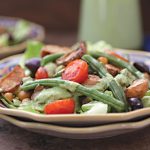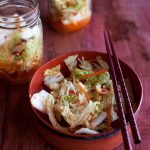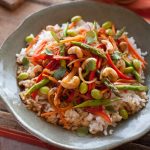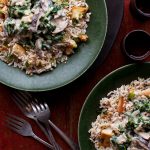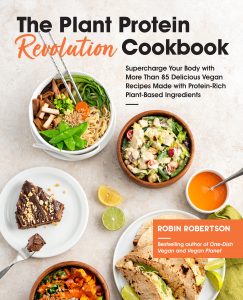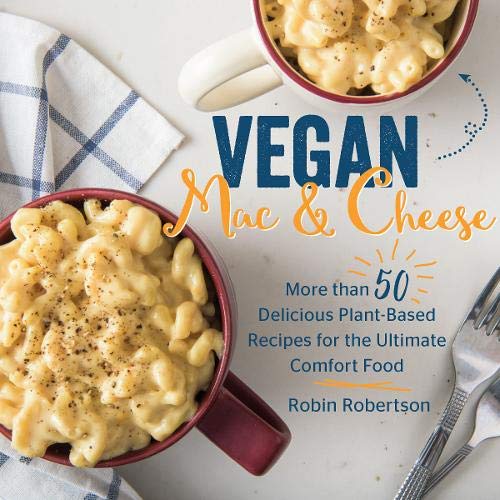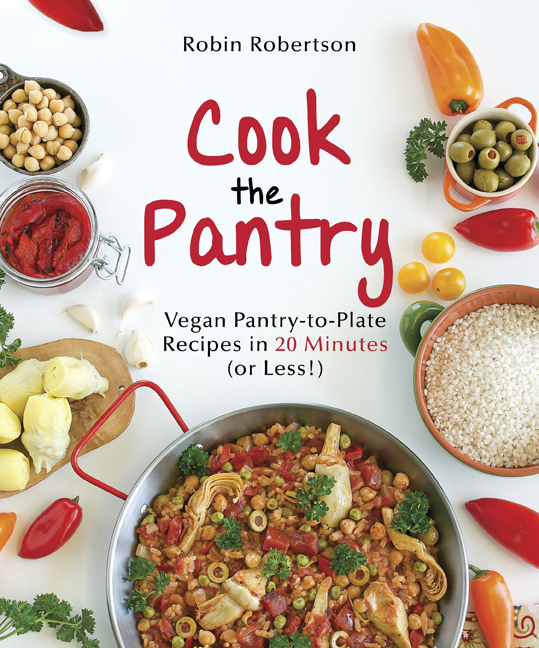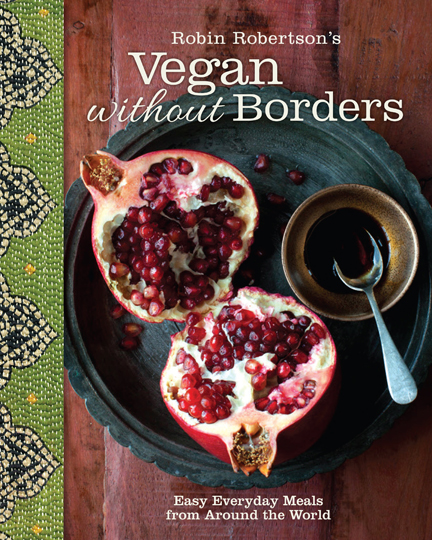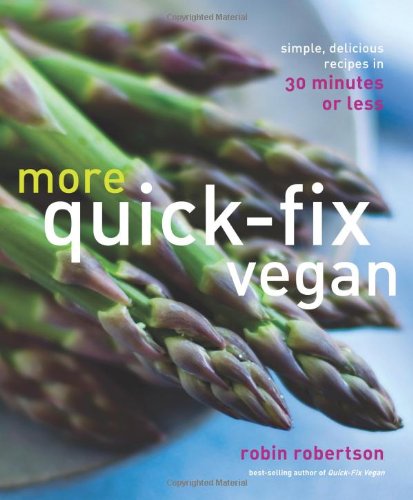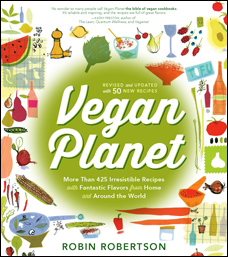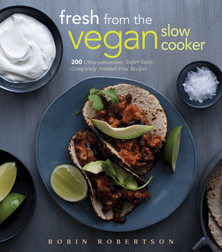by Robin Robertson
on April 17, 2018
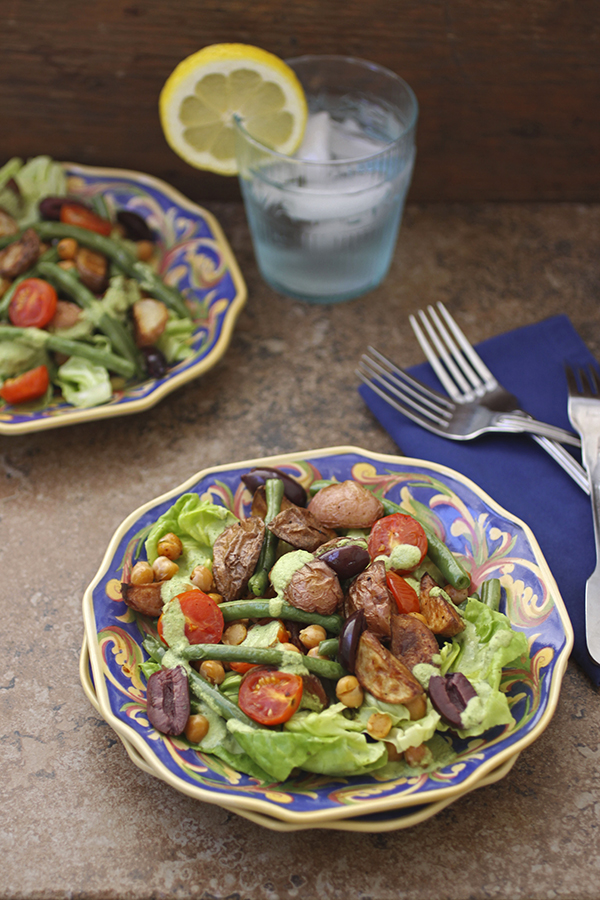 Roasting the potatoes and green beans adds a new layer of flavor to this hearty Niçoise Salad. A creamy cashew dressing provides a rich finish. To make this soy free, use coconut aminos instead of tamari.
Roasting the potatoes and green beans adds a new layer of flavor to this hearty Niçoise Salad. A creamy cashew dressing provides a rich finish. To make this soy free, use coconut aminos instead of tamari.
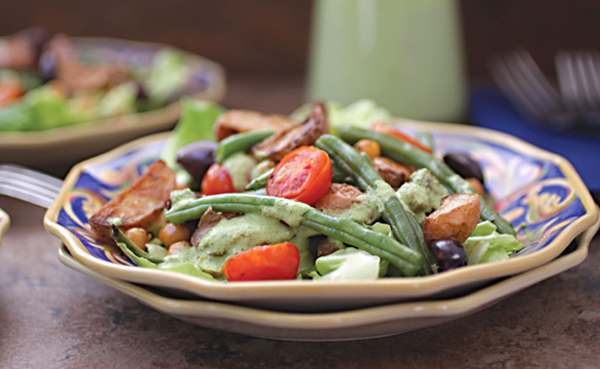
Roasted Niçoise Salad with Cashew Goddess Dressing
Roasting the potatoes and green beans adds a new layer of flavor to this hearty Niçoise Salad. A creamy cashew dressing provides a rich finish. To make this soy free, use coconut aminos instead of tamari.
-
1
pound
small new potatoes, halved or cut into 1/2-inch pieces
-
8
ounces
green beans, steamed
-
1 1/2
cups
cooked or 1 (15.5-ounce) can chickpeas, drained and rinsed
-
1
cup
cherry or grape tomatoes, halved lengthwise
-
1/3
cup
cashews
-
2
scallions, chopped
-
1
garlic clove, crushed
-
3
tablespoons
chopped fresh parsley
-
1/2
cup
plain unsweetened almond milk
-
2
tablespoons
tahini
-
2
tablespoons
rice vinegar
-
1
tablespoon
fresh lemon juice
-
1
tablespoon
wheat-free tamari
-
1/2
teaspoon
salt
-
1/3
cup
kalamata olives, pitted and halved
-
Torn butter lettuce leaves, to serve
-
Preheat the oven to 425°F. Arrange the potatoes on a lightly oiled baking pan and spray with a little cooking spray. Season to taste with salt and pepper and roast until just softened and lightly browned, turning once, about 25 minutes. Add the steamed green beans, chickpeas, and tomatoes. Season with salt and pepper, and spray with a little cooking spray. Return to the oven for 15 minutes.
-
While the vegetables are roasting, make the dress- ing. Grind the cashews in a high-speed blender. If you don’t have a high-speed blender, you can use a food processor but the dressing won’t be as smooth. Add the scallions, garlic, and parsley. Pulse to mince. Add the almond milk, tahini, vinegar, lemon juice, tamari, and salt to taste; process until smooth. Set aside.
-
When the vegetables are roasted, remove from the oven and allow to cool to room temperature.
-
To serve, arrange the lettuce leaves onto four serving plates. Arrange the vegetables on top and drizzle each salad with some of the dressing. Serve immediately.
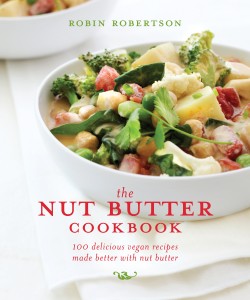
From The Nut Butter Cookbook by Robin Robertson. ©2014 Robin Robertson. Used by permission from Andrews McMeel Publishing. Photo by Lori Maffei.
{ }
by Robin Robertson
on April 10, 2018
 If you go to an Asian market to buy kimchi, the fermented vegetable side dish, be ready for a lot of choices. In addition to several prepared varieties sold in jars, you may be faced with vendors selling their own homemade kimchi from large tubs. While there are similarities to them, each batch of kimchi is as unique as the cook who made it. Cabbage dominates in the most familiar versions, but other ingredients such as daikon radish, carrots, and other vegetables may be included as well, with varying degrees of spiciness. With all those choices, it may be easier to make your own, using this recipe as a starting point, adding more or less garlic, cayenne, or kochijan paste according to taste.
If you go to an Asian market to buy kimchi, the fermented vegetable side dish, be ready for a lot of choices. In addition to several prepared varieties sold in jars, you may be faced with vendors selling their own homemade kimchi from large tubs. While there are similarities to them, each batch of kimchi is as unique as the cook who made it. Cabbage dominates in the most familiar versions, but other ingredients such as daikon radish, carrots, and other vegetables may be included as well, with varying degrees of spiciness. With all those choices, it may be easier to make your own, using this recipe as a starting point, adding more or less garlic, cayenne, or kochijan paste according to taste.
Traditionally kimchee kimchi is left at room temperature for a few days (or longer) to ferment, but my version takes just 24 hours, although the fermentation process will continue (albeit more slowly) once the kimchee kimchi is refrigerated.
Kimchi is rich in vitamins, iron, calcium, and iron, and also low in fat and high in fiber, kimchi’s ; its greatest health benefit is a result of its fermentation process that creates good or “healthy” bacteria (the same kind found in yogurt or sauerkraut) which in turn, preserves the vegetables and gives them their distinctive tangy flavor.
24-hour Kimchi
Traditionally kimchee kimchi is left at room temperature for a few days (or longer) to ferment, but my version takes just 24 hours, although the fermentation process will continue (albeit more slowly) once the kimchee kimchi is refrigerated.
-
5
cups
coarsely chopped napa cabbage
-
1
carrot, peeled and thinly sliced
-
1/2
cup
chopped scallions
-
4
cups
water
-
2
teaspoons
salt
-
3
cloves
garlic cloves
-
1
teaspoon
grated fresh ginger
-
1
tablespoon
cayenne or 2 tablespoons kochijan paste combined with 1 tablespoon hot water
-
2
tablespoons
rice vinegar
-
1/4
teaspoon
freshly ground black pepper
-
In a large bowl, combine the cabbage, carrot, and scallion. Add the salt and water. Place a plate inside the bowl to hold the vegetables under water. Cover and set aside for 4 hours.
-
Drain well and discard the salt water. Rinse the vegetables well and drain again, squeezing out any remaining liquid.
-
In a small bowl, combine the garlic, ginger, cayenne mixture, vinegar, and pepper. Mix well. Add to the reserved vegetables and mix well to coat.
-
Cover tightly and set aside on the kitchen counter to ferment overnight. Taste and adjust the seasonings, if needed. Store in an airtight container in the refrigerator where it will continue to ferment at a slower rate. Properly stored, the kimchi will keep in the refrigerator for several weeks.

This recipe is from Vegan Without Borders © Robin Robertson, 2014, Andrews McMeel Publishing, photo by Sara Remington.
{ }
by Robin Robertson
on April 3, 2018
 This dish is filled with the fresh fragrant flavors of lemongrass and cilantro, and loaded with edamame, asparagus, carrots, cashews, and other goodies. This Lemongrass Asparagus and Edamame Stir-fry is seasoned with a luscious sauce made with vegan oyster sauce, rice vinegar, and sambal oelek, a paste of ground hot chiles. Even though it’s a long list of ingredients, it goes together quickly – —the hardest thing about this stir-fry is not eating the whole thing yourself in one sitting.
This dish is filled with the fresh fragrant flavors of lemongrass and cilantro, and loaded with edamame, asparagus, carrots, cashews, and other goodies. This Lemongrass Asparagus and Edamame Stir-fry is seasoned with a luscious sauce made with vegan oyster sauce, rice vinegar, and sambal oelek, a paste of ground hot chiles. Even though it’s a long list of ingredients, it goes together quickly – —the hardest thing about this stir-fry is not eating the whole thing yourself in one sitting.
Lemongrass Asparagus and Edamame Stir-fry
This dish is filled with the fresh fragrant flavors of lemongrass and cilantro, and loaded with edamame, asparagus, carrots, cashews, and other goodies. It’s seasoned with a luscious sauce made with vegan oyster sauce, rice vinegar, and sambal oelek, a paste of ground hot chiles. Even though it’s a long list of ingredients, it goes together quickly – —the hardest thing about this stir-fry is not eating the whole thing yourself in one sitting.
-
1/4
cup
soy sauce
-
1/4
cup
water
-
2
tablespoons
vegan oyster sauce
-
2
tablespoons
rice vinegar
-
1
teaspoon
sambal oelek (ground fresh chili paste)
-
1
teaspoon
ground coriander
-
1
teaspoon
natural sugar
-
1
tablespoon
neutral vegetable oil
-
1
medium yellow onion, halved lengthwise, then thinly sliced
-
3
cloves
garlic cloves, minced
-
2
fresh lemongrass stalks, tender inner white bulb only, minced
-
1
teaspoon
grated fresh ginger
-
12
ounces
thin asparagus, trimmed, and cut diagonally into 1 1/2-inch pieces
-
1
red bell pepper, seeded and cut into julienne strips
-
1
cup
steamed fresh or frozen shelled edamame
-
2
medium-size carrots, coarsely shredded
-
1/2
cup
chopped fresh cilantro or basil
-
1/4
cup
toasted cashews
-
3 to 4
cups
freshly cooked long-grain rice
for serving
-
In a small bowl, combine the soy sauce, water, oyster sauce, vinegar, sambal oelek, coriander, and sugar. Stir to mix well. Set aside.
-
Heat the oil in a large wok or large skillet over high heat. Add the onion, garlic, lemongrass, and ginger, and stir-fry for 30 seconds. Add the asparagus, bell pepper, edamame, and carrots. Stir-fry for 3 minutes, then stir in the reserved sauce and bring to a boil. Lower the heat to a simmer and cook for about 3 minutes to reduce the sauce a little. Stir in the cilantro and cashews. Taste and adjust the seasonings if needed. Serve hot with rice.
Note: Vegan oyster sauce is sold at Asian markets –— it is labeled as “vegetarian” oyster sauce. If unavailable, look for mushroom soy sauce. If you can’t find either, you can omit it and just add a little extra of your regular soy sauce, as needed.

This recipe is from Vegan Without Borders © Robin Robertson, 2014, Andrews McMeel Publishing, photo by Sara Remington.
{ }
by Robin Robertson
on March 27, 2018
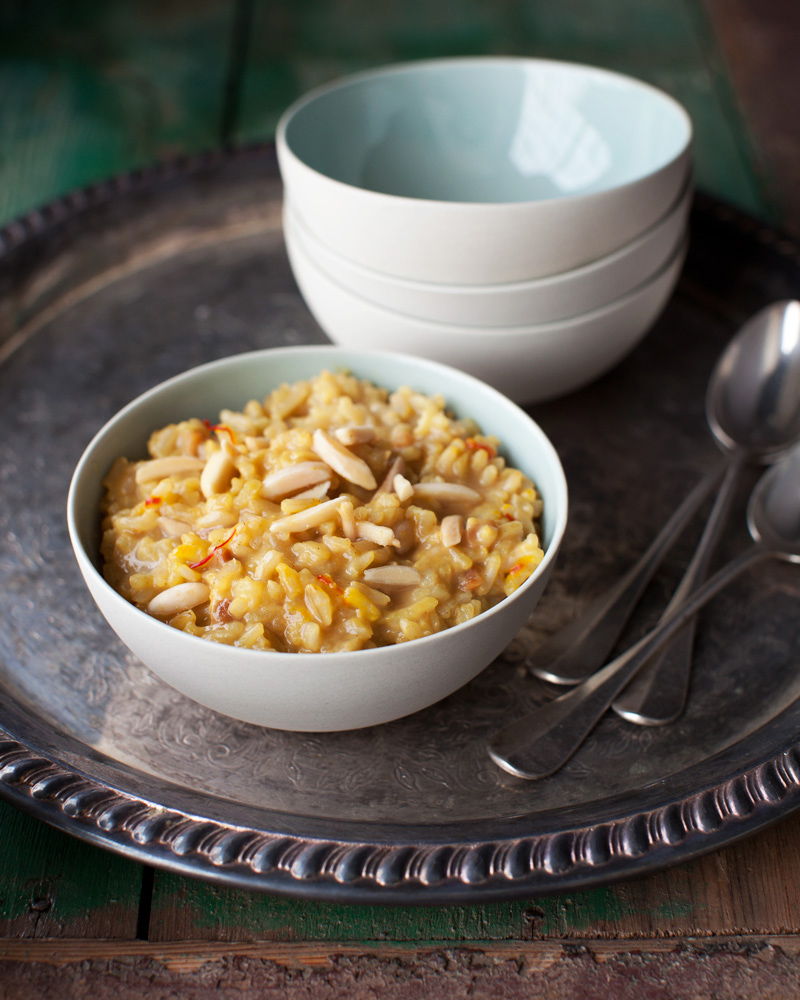 I prefer to make rice pudding using leftover cooked rice rather than starting from scratch with raw rice because it’s quicker and it’s a great way to use leftover rice. My favorite rice for rice pudding is brown basmati rice, but if you like a creamier texture, try sushi rice, arborio rice, or jasmine rice.
I prefer to make rice pudding using leftover cooked rice rather than starting from scratch with raw rice because it’s quicker and it’s a great way to use leftover rice. My favorite rice for rice pudding is brown basmati rice, but if you like a creamier texture, try sushi rice, arborio rice, or jasmine rice.
Saffron-Almond Rice Pudding
I prefer to make rice pudding using leftover cooked rice (rather than starting from scratch with raw rice because it’s quicker and it’s a great way to use leftover rice. My favorite rice for rice pudding is brown basmati rice, but if you like a creamier texture, try sushi rice, arborio rice, or jasmine rice.
-
1
tablespoon
pure maple syrup or agave nectar
-
1
tablespoon
almond butter
-
2
teaspoons
natural sugar
-
1/2
teaspoon
ground cinnamon
-
Few pinches saffron
-
1/8
teaspoon
salt
-
1
cup
almond milk
-
2
cups
cooked basmati rice (or your favorite rice)
-
1/2
cup
toasted slivered almonds
-
In a small saucepan, combine the maple syrup, almond butter, sugar, cinnamon, saffron, and salt over medium heat. Slowly add the almond milk, stirring to blend. Add the cooked rice and cook, stirring until the rice is heated through and the mixture begins to thicken. Decrease the heat to medium-low, stirring occasionally, until the desired consistency is reached. For a thinner pudding, add a little more almond milk. For a creamier texture, use an immersion blender to blend a portion of the rice pudding right in the saucepan. To serve spoon the pudding into bowls and sprinkle with toasted almonds.
This recipe is from Vegan Without Borders © Robin Robertson, 2014, Andrews McMeel Publishing, photo by Sara Remington.

This recipe is from Vegan Without Borders © Robin Robertson, 2014, Andrews McMeel Publishing, photo by Sara Remington.
{ }
by Robin Robertson
on March 20, 2018
 These vegan Coconut Cupcakes look especially pretty with toasted large flakes of toasted coconut sprinkled on the frosting. They’re a great treat to serve on Easter.
These vegan Coconut Cupcakes look especially pretty with toasted large flakes of toasted coconut sprinkled on the frosting. They’re a great treat to serve on Easter.
Coconut Cupcakes
These cupcakes look especially pretty with toasted large flakes of toasted coconut sprinkled on the frosting.
Cupcakes:
-
3/4
cup
coconut milk
-
1
teaspoon
apple cider vinegar
-
1 1/4
cups
all-purpose flour
-
2
tablespoons
cornstarch
-
1
teaspoon
ground nutmeg
-
1/
teaspoon
salt
-
1
teaspoon
baking powder
-
1/4
teaspoon
baking soda
-
1/
teaspoon
salt
-
3/4
cup
granulated sugar
-
3
tablespoons
coconut oil, melted
-
1
teaspoon
coconut extract
Frosting:
-
1/3
cup
vegan butter
-
2
cups
confectioners’ sugar
-
1
teaspoon
coconut extract
-
Lightly toasted flaked coconut
for garnish
-
Cupcakes: Preheat the oven to 350° degrees F. Line a 12-cup muffin tin with cupcake liners. Set aside.
-
In a small bowl, combine the coconut milk and vinegar and set aside. In a medium bowl, combine the flour, cornstarch, nutmeg, salt, baking powder, and baking soda, and salt. Mix to combine.
-
In a large bowl, combine the sugar, oil, and coconut extract. Stir in the reserved coconut milk mixture. Add the dry ingredients to the wet ingredients and stir until smooth.
-
Pour the batter evenly into the prepared tin and bake until a toothpick inserted in the center of a cupcake comes out clean, 20 to 25 minutes. Cool completely before frosting.
-
Frosting: While the cupcakes are cooling, make the frosting. In a large bowl, cream the butter with an electric mixer on high speed until light and fluffy. Alternatively, process it in a food processor. Add the confectioners’ sugar and coconut extract and mix until thoroughly combined. Continue mixing for about 2 minutes, or until the frosting is smooth and stiff. Refrigerate until needed.
-
To assemble: When the cupcakes are completed cooled, frost the cooled cupcakes with the prepared frosting. Place the flaked coconut in a shallow bowl, then dip the top of each cupcake into the shredded coconut.
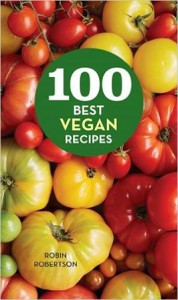
Excerpted from 100 BEST VEGAN RECIPES, © 2016 by Robin Robertson. Used with permission of Houghton Mifflin Harcourt. All rights reserved. Photo by Lucy Schaeffer.
SaveSaveSaveSave
{ }
by Robin Robertson
on March 13, 2018
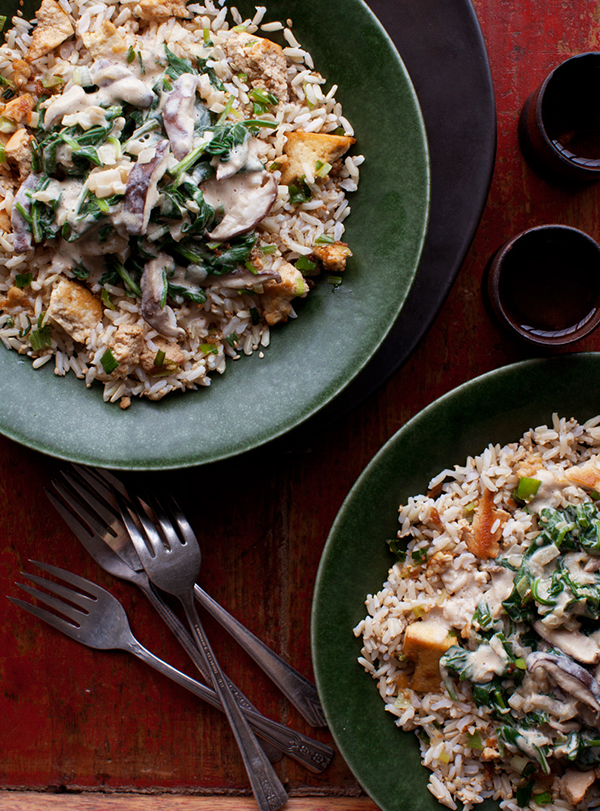
I’ve been a fan of donburi since I first tasted it when a friend brought me to a small Japanese restaurant in New York City. The restaurant, more of a lunchroom, had no sign and was on the second floor above some shops. The room contained several long tables that were filled with Japanese people enjoying their lunch: the rice bowl dish known as donburi. A kind of Japanese fast food, donburi is boiled rice topped with fish, meat, eggs, or vegetables simmered in a dashi broth made with soy sauce and mirin.
This vegan donburi recipe features a topping of one of my other favorite Japanese dishes: gomai, which is spinach with a sesame sauce. The combination of donburi and gomai are Japanese comfort food at its finest.
Sesame-Spinach Donburi
This vegan donburi recipe features a topping of one of my other favorite Japanese dishes: gomai, which is spinach with a sesame sauce. The combination of donburi and gomai are Japanese comfort food at its finest.
-
3/4
cup
unsweetened coconut milk
-
3
tablespoons
tahini (sesame paste)
-
3
tablespoons
soy sauce, divided
-
1
tablespoon
neutral vegetable oil or 1/4 cup water
-
1
medium yellow onion, finely chopped
-
8
shiitake mushrooms, stemmed and thinly sliced
-
1
teaspoon
grated fresh ginger
-
10
ounces
fresh spinach, well washed and coarsely chopped
-
Salt and freshly ground black pepper
-
2
teaspoons
toasted sesame oil
-
8
ounces
extra-firm tofu, drained and crumbled
-
3
scallions, minced
-
3
cups
cooked brown rice
-
2
tablespoons
toasted sesame seeds
-
In a small bowl, combine the coconut milk, 2 tablespoons of the soy sauce, and tahini, stirring until blended. Set aside.
-
Heat the oil or water in a large skillet over medium heat. Add the onion and cook until soft, about 5 minutes. Add the mushrooms and ginger, and cook for 30 seconds. Add the spinach and stir-fry until wilted, about 2 minutes. Stir in the reserved coconut milk, soy sauce, and tahini mixture, and salt and pepper to taste. Simmer, stirring frequently, until hot and creamy, 5 to 7 minutes.
-
Heat the sesame oil in a large skillet or wok over medium heat. Add the tofu, scallions, and remaining tablespoon of soy sauce and cook, stirring to coat. Add the cooked rice and sesame seeds, and season with salt and pepper to taste. Toss to combine and heat through. Spoon the rice mixture among individual bowls, top each with the spinach mixture and serve hot.

This recipe is from Vegan Without Borders © Robin Robertson, 2014, Andrews McMeel Publishing, photo by Sara Remington.
{ }
 Roasting the potatoes and green beans adds a new layer of flavor to this hearty Niçoise Salad. A creamy cashew dressing provides a rich finish. To make this soy free, use coconut aminos instead of tamari.
Roasting the potatoes and green beans adds a new layer of flavor to this hearty Niçoise Salad. A creamy cashew dressing provides a rich finish. To make this soy free, use coconut aminos instead of tamari.